PAKISTAN – Karakoram Highway (KKH) Sost to Gilgit
7th November
We cross the Khunjerab Pass at a height of 4700 metres, crossing from China to Pakistan. We feel relieved to have made it this far but are apprehensive about the next 84km before we reach the main Pakistani immigration post as we do not have a Pakistani visa. We have heard that it is possible to obtain the visa on the border, but we were unable to find any official confirmation of this. The worst case scenario would be being prevented from entering Pakistan and being stuck in no-man’s land between Pakistan and China.
KKH
The Karakoram Highway (KKH), also known as the Friendship Highway in China, is the highest paved international road in the world. It connects China and Pakistan across the Karakoram mountain range, through the Khunjerab Pass, at an altitude of 4693m/15397 feet. The KKH (1200km long) passes the highest concentration of soaring peaks and glaciers in the world, five of which are over 8000m. The road passes through the point where three great mountain ranges meet, the Hindukush, the Himalaya and the Karakoram ranges.
The road has recently severely deteriorated due to the flooding, with many sections of the road and bridges being either submerged or simply washed away by the rivers; regular landslides and rock falls still occur and happen without warning. At times these have blocked the road and cut off villages for up to 40 days.
The Border
As we cross the Pakistani border, the road suddenly deteriorates from a perfect tarmac road to a rocky, icy, dirt track. At the speed we are currently able to drive- a mere 40kmh, it will take us just over two hours to reach the main border post.
We see the Pakistani check point, where they briefly flick through our passports and welcome us to Pakistan.
The temperature is minus 3 outside as we pass frozen lakes and streams. The road starts to descend towards Sost.
We see a group of workmen on the road; I wave at them, to have all of them wave back in unison.
I forget that in Pakistan they drive on the left and for a second wonder why the truck coming towards us is on our side of the road!
After an hour or so we arrive at the second Pakistani check point; a quick glance at the passports and he waves us through.
The road now deteriorates further, partially fallen away in the river and valley below, there are lots of rocks and large boulders.
The road turns back to a smooth dirt track but we wonder how long for. We see Chinese workers building new bridges, tunnels and sections of the road. In many places, the road has simply been washed away or large rock falls have completely blocked it. We see two Chinese men carrying a large boulder with some rope and a plank of wood between their shoulders. The Chinese appear to be rebuilding the road by hand, with little heavy machinery!
We are still at 3400m, seeing huge trucks, and wonder how they will manage to get up the tiny dirt tracks we have just navigated.
The Chinese are building tunnels along the road to prevent future rock falls and mudslides from blocking the road again.
We arrive at the next checkpoint at Dih, where the Khunjerab National park office is situated and have to pay $4 each to enter. The men in the office are very friendly and change our Chinese money for us and invite us for tea.
As we drive further down the valley the river becomes much larger and faster, as the icy streams and springs pour in to the river.
As we arrive at Sost, the border guard asks us “Visa?” We tell him we do not have one to be told, “No visa, no problem, visa one month”.
We are taken into the immigration office, where we meet our guide Ayub. It seems the immigration chief who issues visas has disappeared, and we are told he did not expect any travellers until after 3pm. An hour later he turns up and apologies for the delay. We are charged $90 each for our 30 day visas. We then move on to the customs office, who complete our Carnet Du Passage and checks for the vehicle.
With it getting late we are not sure whether we will get to Attabad Lake on time for the boat, before dark. If we do not get there on time, we will have to find somewhere to stay in Passu.
Attabad Lake
We finally arrive at Attabad Lake just as the sun is going down. The lake is 24km long and up to 100 meters deep , at an altitude of about 2700m and surrounded by 6000m-7000m peaks and glaciers. The lake formed due to a massive landslide at Attabad village in Gilgit-Baltistan, on January 4, 2010. The landslide killed twenty people, buried and inundated the Karakoram Highway and blocked the flow of the Hunza River for five months. The lake flooding has displaced 6,000 people from upstream villages, stranded (from land transportation routes) a further 25,000, and inundated over 12 miles (19 km) of the Karakoram Highway. For now all goods have to be unloaded and loaded at each side of the lake, there is simply no other way through the mountains, adding additional costs to the trader’s goods.
In the last few months, the local people at times have been cut off from all food and electricity. Finally goods are starting to move; however the prices of fuel, sugar, rice, flour have significantly risen. In addition to this the only way people are able to move from one village to the next is by boat, which for some is too costly, and in some cases prevents the local children from reaching their schools.
Many have lost their incomes, their personal possessions, their homes, but also their families. With winter coming we fear that more may lose their life due to not being able to obtain the necessities to survive throughout the winter.
Many locals for the past few months have feared that the lake may burst, and flood lower lying villages all the way down to Gilgit, which has also had a negative effect on local tourism. For now the lake seems safe, but come spring, the flood waters may well rise again.
There is a large queue of trucks loading and unloading. We are not sure what to expect and are told a boat has been organised for us. Looking around there does not seem anywhere stable to actually load the vehicle, with the lake banks very steep and rocky.
Our boat finally arrives identified by a black flag. I’m quite shocked that it is not much larger than the car. The guide shows us two planks of wood and explains that we will put the planks of wood across the width of the boat.
At this point I can’t really see how this will work or how we will even get the car down to the loading point….
The boat unloads its cargo, and I’m told it is now ready for us to board. Looking down the steep slope, I’m worried it may be too steep for the car. We try to move trucks out of the way so that we can attempt the descent at a safer point, but the driver has gone missing.
With it starting to get dark, the guide suggests that maybe we wait until tomorrow, for either the army raft or another boat which may be much more expensive; although at least the army raft is actually built to handle cars and trucks.
We finally agree to give it a go. We slowly navigate to the lakes shore, where it is quite sandy. With a large crowd of people around us, we prepare the boat and the car for loading.
Two planks of wood are put over the boat to the shore line with a few rocks underneath to keep them steady. Very slowly I move the car forward on the planks, being given directions and instructions by about 10 different people, it becomes quite stressful. Slowly we move up the planks, until the car is about centre.
A stone is placed in front of each wheel to stop the car rolling off the planks of wood. I’m not sure that would be enough!!
A local policeman checks the load and is somehow happy for us to leave!
Unfortunately, with the car being heavier at the back than the front, the boat starts to tilt to one side, with the car perilously hanging on. About 10 passengers join the boat and are asked to sit on the lighter side of the boat.
As we cruise down the river in darkness, the boats crew have small flashlights to navigate the lake, being careful to avoid submerged building, bridges, and pylons. The local electricity supply is out and the small villages along the lake are in pitch black, giving us a magnificent view of the stars above. The plan is to cruise 4km down the lake to the Marco Polo Hotel in Gulmit where we will unload the car and spend a couple of days before re-boarding the boat to complete the other 20km of the lake.
Unfortunately, as we pull in to unload the boat, we find the path is blocked by large sacks of potatoes. A few passengers at this point leave the boat, which in turn makes it lean to one side. There are not enough people left on the boat to keep it completely level. With every turn, my heart pounds watching the car tilting on the planks of wood, which at this point are nearly touching the water. We try another spot but it is just too steep and sandy.
We don’t really have many choices at this point as it is too dangerous to continue down the lake in the darkness so we decide to moor the boat, with the car still on board. We move the car slightly to make the boat more level, just in case anything happens during the night. We also ask the captain to stay with the car / boat over night to look after it. With the temperature expected to be below freezing, we feel quite sorry for the captain, and offer him some extra blankets.
We leave the boat and walk, for about 15 minutes in darkness to the hotel along narrow winding paths. The village power supply is out this evening so there is no heating or lights, just a few candles.
We meet the hotel owner, who tells us of his family history; his grandfather, Mir Nazeem Khan was the ruler of Hunza from 1892 to 1938.
We head to bed early worn out from our drive and the excitement of the trip so far.
8th November
We wake up early for breakfast, an hour early due to our clocks being an hour wrong. We have breakfast of pancakes and omelette.
The hotel owner receives a message that our car is still there, on the boat. After breakfast we head down to the lake to continue our trip. We are asked if we would also be able to take a few local people on the boat too, which we gladly do..
We continue our trip down the lake and with the morning sun rising over the mountains the trip is pleasant. We pass many stranded villages with people waiting in the sun for the next boat to arrive. The lake is surrounded by massive mountains up to 7000m high. As we pass into the shade, we feel the cold as we are still at about 2700m.
We arrive at the other end of the lake to see long queues of trucks, and what seems to be complete mayhem.
Again the lake edge is steep, sandy and rocky. With another large crowd of onlookers, we prepare the car and boat so we can disembark, this time backwards!
Some locals help prepare the boat. The height of the bank is a bit higher than the vehicle so we have to very carefully lift the planks up, which makes the front lean quite dangerously towards the water..
I very slowly move the car backwards… with the front left wheel half off the wooden plank I fear it will fall and crash in to the bottom of the boat. I manage to get the rear wheels onto the steep river bank. I put my foot on the gas and move quickly up the bank hoping that when I stop to turn around the car does not slide back down the steep powdery bank. Made it!
Once up on the bank we find we are blocked in by trucks and would have to wait for them to load before continuing. The next 1km of road is made up of deep white powdery sand.
We head to Karimabad, where we visit a local precious stone workshop. All around the valley there are large amounts of Rubies, Emeralds and Quartz to be found and many locals make a small living out of either making the jewellery, cutting the stones or mining them. The workshop we visited was currently training locally displaced people as jewellery makers. On the walls of the workshop were pictures of Prince Charles who also visited the workshop several years ago.
We move on to the Baltit fort built in the 13th Century, and recently restored.
After visiting the fort we head up to our hotel ‘The Eagles Nest’ where we will stay for a couple of nights. The hotel is perched on a 2850 metre high ridge above Altit village in the Hunza valley. The hotel has fantastic views of both the valley and the surrounding mountains including Rakaposhi at (7788m) Golden peak (7027), Ultar (7388m) and Lady’s Finger.
In the evening we have dinner at our hotel, a white Chicken Korma, Chicken Jalfrazi and Chicken Biriani. All was good apart from the Jalfrazi, which was not spicy and had bare bones rather than meat in it.
9th November
In the morning we wake to have breakfast overlooking the valley, and then head down to the small village of Altit below with our guide and the hotel owner. We tour the narrow streets of mud covered buildings which have not changed in the last 400 years. We are invited into a small house, to have a look around, which Prince Charles also visited.
We then head to Hoper to see the glacier with our guide and the hotel owner.
The road is narrow and bumpy, as it zigzags up the valley. We pass through various small villages along the way, with young boys playing cricket.
We reach the end of the road at Hoper and pull into a small restaurant where we park the car to walk to the glacier.
We head up the hill to be greeted by a mob of old men trying to sell uncut Rubies, Emeralds and polished Quartz. After a bit of haggling and examination of the stones we agree to buy a medium sized uncut Ruby for 200RP which is only £1.40!
We head down a steep path towards the glacier. On our way I scour the rocks in the hope of finding more rubies, but to no avail, I just find lots of quartz. A group of 4 boys tag along with us, and provide Nicole with some help climbing down the steep narrow path.
We stop to rest and take in the views for half an hour before continuing back up the valley. Again Nicole’s “helpers” look after her all the way up!
Once we return to the restaurant we buy the boys some biscuits to thank them for their help.
On our way back we pass another group of cricket playing children. This time though, they chase the car down the road shouting, and one very young boy throws a stone at the car.
We return to the hotel in the late afternoon and relax for the rest of the night, before having dinner again in the hotel restaurant.
Click here to leave a comment!
Martin & Nicole


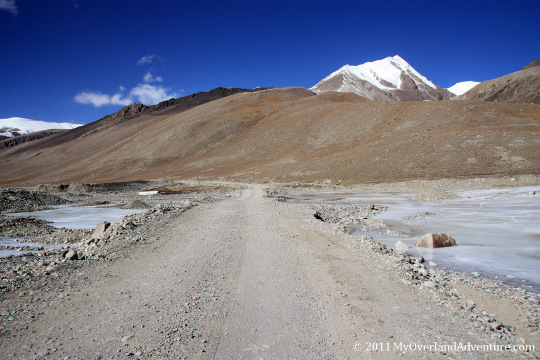
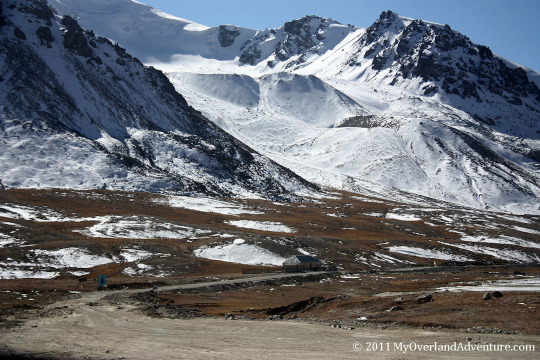
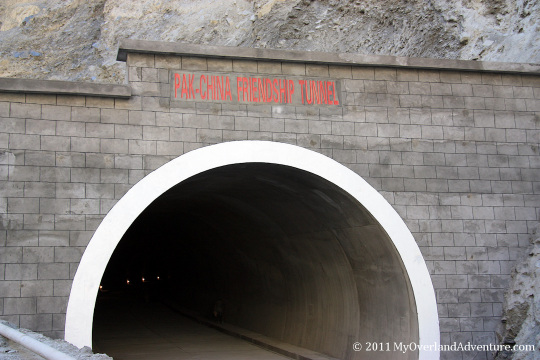
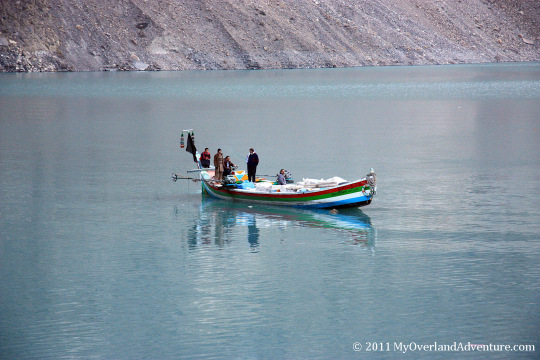

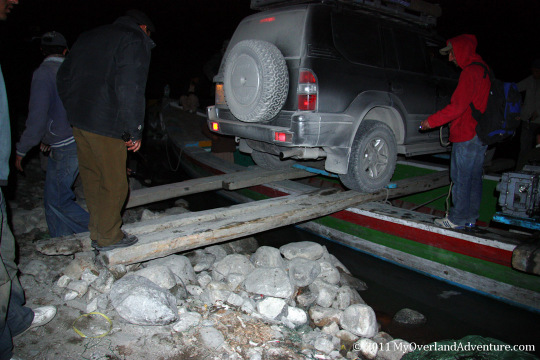
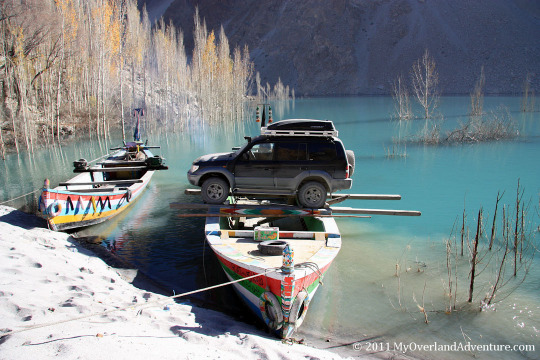
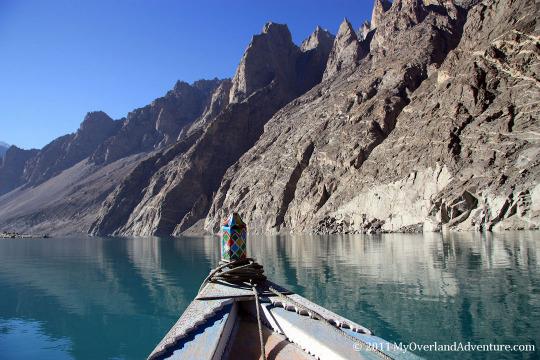
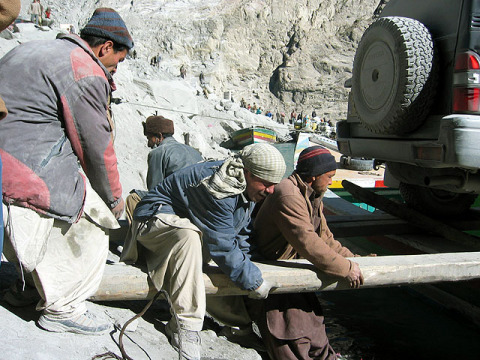
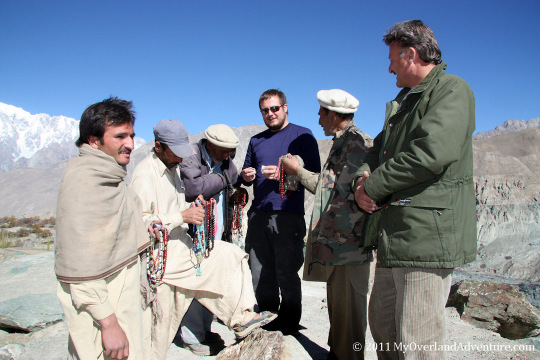
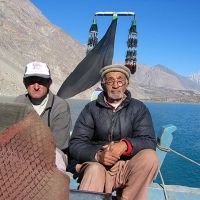
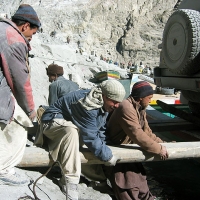
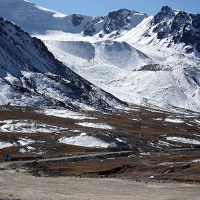
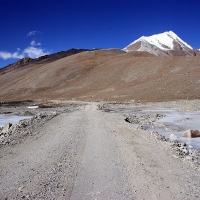
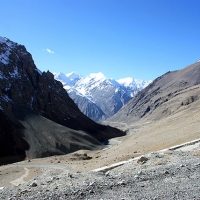
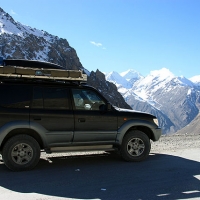
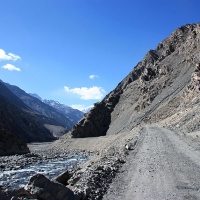
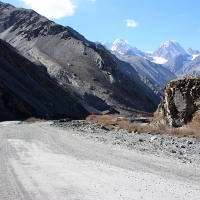
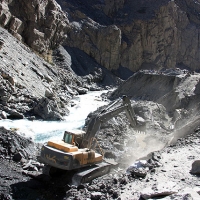
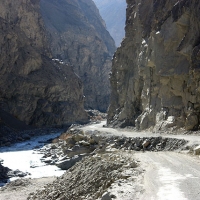
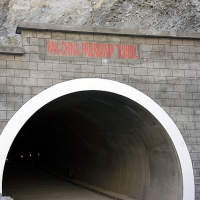
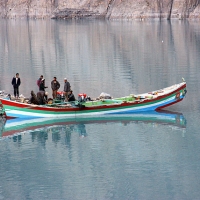
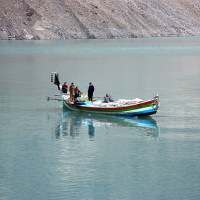
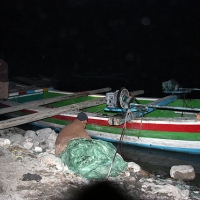
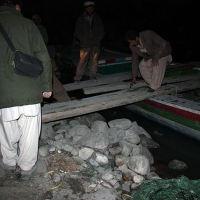
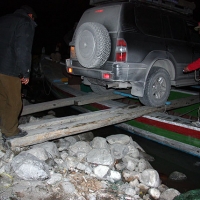
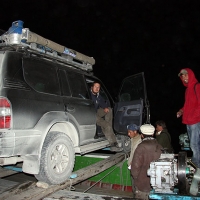
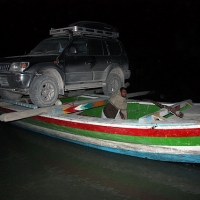
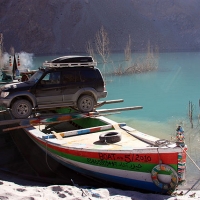
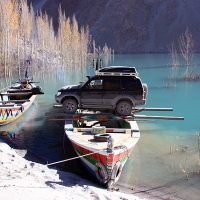



Hi There,
Lovely blog and fascinating stories!! What an incredible journey. Just a quick one–you mentioned meeting a guide at the border. did you have a guide throughout Pakistan?
We are considering this addition to our trip but would love some more information.
I know this was years ago, but any info you may have would be great.
Thanks,
Amanda
Loved it. Thanks for visiting too. My homeland will rise again we will see more of our friends will visit 🙂
Hi guys,
I’d love to publish a story of your adventures in my quarterly 4X4 magazine, particularly with the perilous boat ride leg!
If you’re interested, shoot me an email.
Cheers,
Pat
Nice travel in world. Welcome in Mongolia
I did the KKH a few years ago in a Pakistani ‘Jeep’ (Toyota running gear and Jeep body). It was fantastic. But there is no way I would dare put my wheels on a boat like you did.
You are either very brave or mad!! Well done.
awe inspiring.pl continue with many more pics.tnx in adv.
Read about this lake formed by major avalanche of rocks and mud. Caused major damages to people and property. Looks so calm after the disaster like valcano after erruption. Pictures are simply superb.
Dwarak
Hey – What a read…. Just came upon your message on LandcruiserClub. Welcome.
I used to run trips in Gilgit/Hunza area in the late 1980’s, so loved seeing your photos. So many memories.
The lake looks like fascinating addition…. The drive was spectacular before!!! Has the rope bridge which went straight into a tunnel gone? If it was still there I would have thought you would have put a photo up…
Happy and Safe Travels
Best wishes
Graham
Having read your blog, it’s taken us some time to take it all in with our hearts still thumping! What it must have felt for you, god alone knows!!!!!!
We are pleased it’s all going well. It’s truly remarkable and inspiring the way you have overcome the terrifying obstacles in your way. You will be telling the stories of your adventures for a long time to come. Not many people have the robustness or the will to do something like this least of all us! We are very proud of what you’ve achieved so far and of course there’s lots more to come!
Somehow snow and leaves on the line pale into insignificance!
Wish you every good fortune and good health for your journey onwards.
Lots of love
Mum and Dad xxxxxxxxxxxxxxxxxxxxxxxxxxx